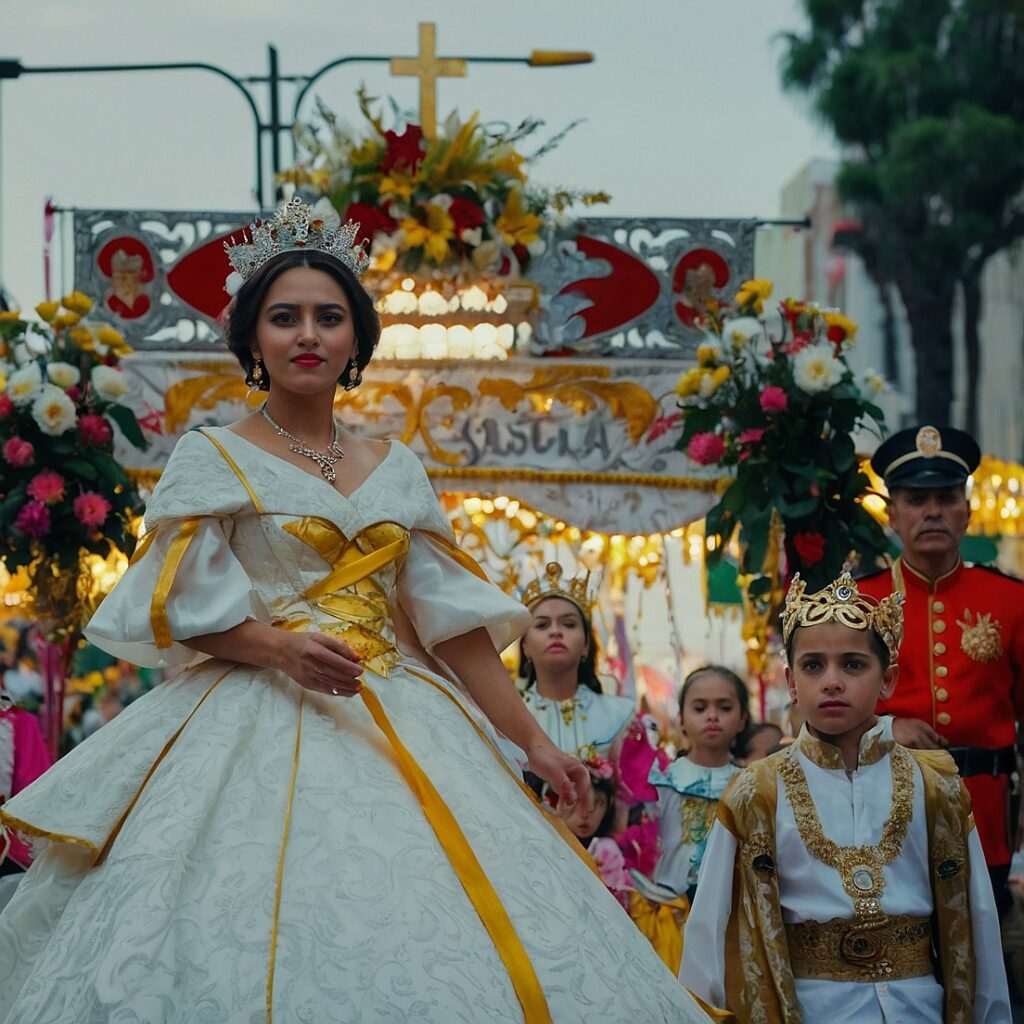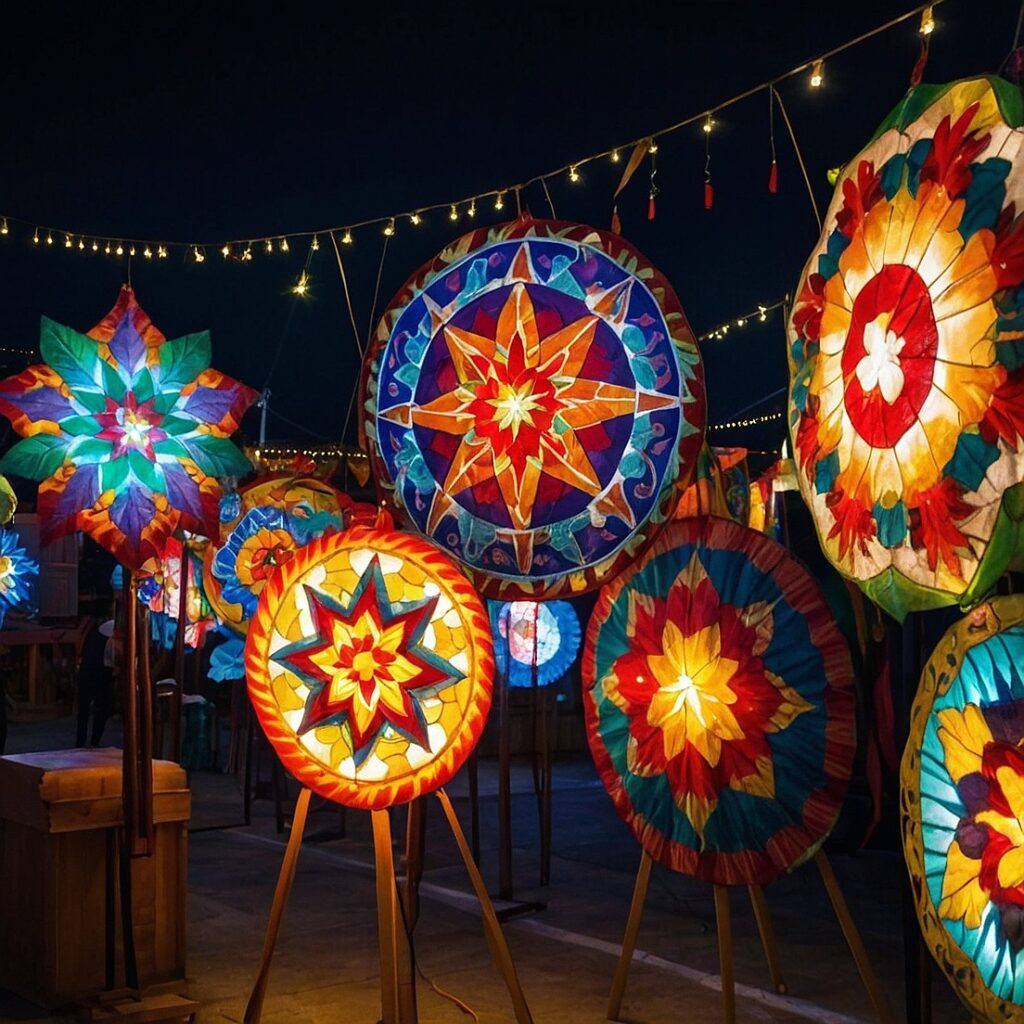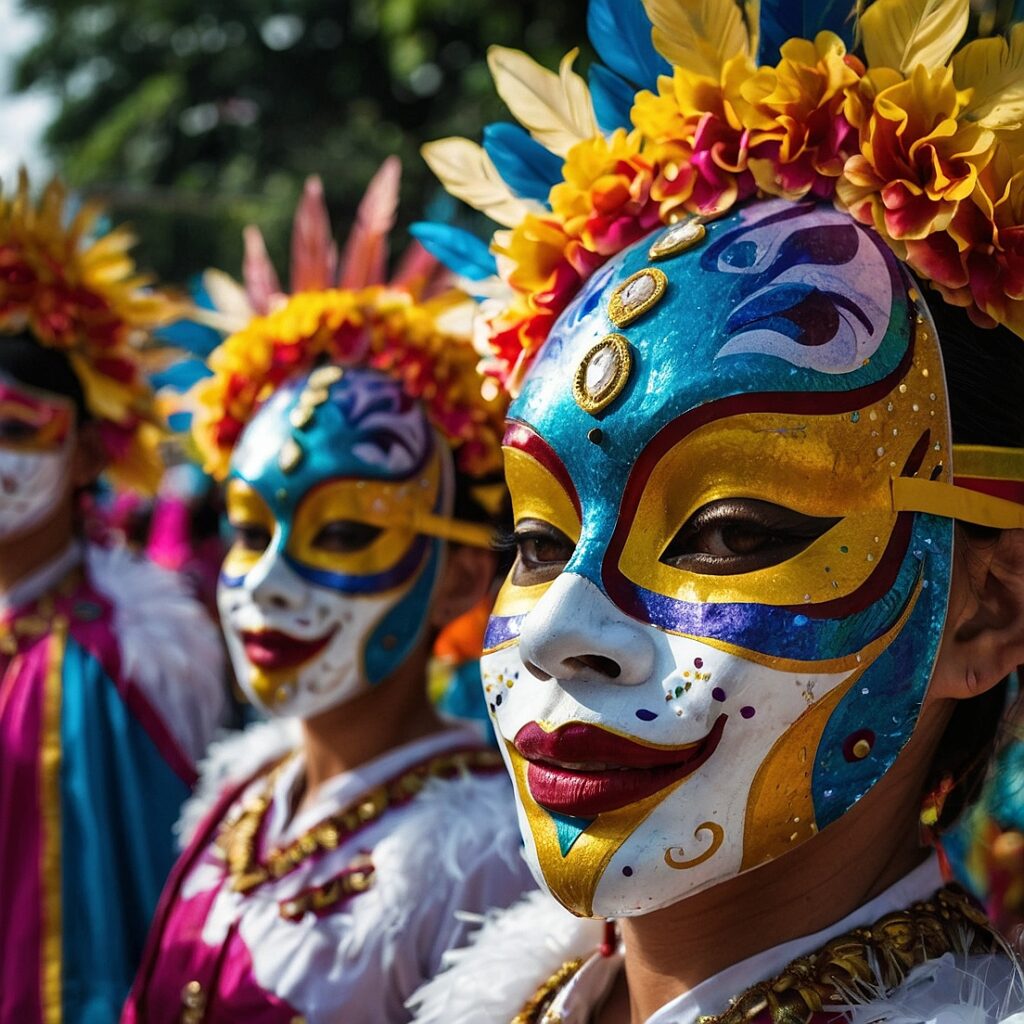Welcome, dear readers, to a vibrant journey through one of the Philippines’ most cherished and visually stunning traditions – the Santacruzan! If you’ve ever wondered about those enchanting parades that light up Filipino communities every May, you’re in for a treat. Santacruzan isn’t just a feast for the eyes; it’s a rich tapestry of history, faith, and culture that has been captivating hearts for generations. In this blog, we’ll dive deep into the origins, significance, and modern-day celebrations of this beloved Filipino custom. So, grab a cup of your favorite beverage, get cozy, and let’s embark on this colorful adventure together!
The Historical Roots: A Tale of Discovery and Devotion
The Story of Helena and the True Cross
At the heart of Santacruzan lies a fascinating historical tale that takes us back to the 4th century AD. Our protagonist? None other than Helena of Constantinople, also known as Saint Helena. Now, Helena wasn’t just any ordinary woman – she was the mother of Roman Emperor Constantine the Great. But what made her truly extraordinary was her legendary quest to find the True Cross, the very cross on which Jesus Christ was crucified.
Legend has it that in 326 AD, Helena embarked on a pilgrimage to Jerusalem. Despite being in her late 70s (talk about determination!), she was on a mission to uncover sacred relics associated with Jesus’ life and crucifixion. The story goes that Helena’s search led her to the discovery of three crosses at the site believed to be Calvary. But how to determine which one was the True Cross? According to tradition, a miraculous healing confirmed its authenticity.
This discovery was monumental, not just for Helena but for the entire Christian world. It sparked a renewed devotion to the cross and elevated Helena to sainthood. Her feast day, August 18, became a day of celebration in the Christian calendar. But you might be wondering, “What does this have to do with a Filipino festival in May?” Well, that’s where our story takes an interesting turn!
From European Tradition to Filipino Celebration
The journey of Santacruzan from a European religious observance to a vibrant Filipino festival is a testament to the country’s unique cultural blend. When Spanish colonizers arrived in the Philippines in the 16th century, they brought with them not just their language and governance but also their religious traditions. Among these was the Flores de Mayo (Flowers of May), a month-long festival honoring the Virgin Mary.
Over time, the Filipinos, known for their love of pageantry and celebration, adopted and adapted these traditions. The commemoration of Saint Helena’s finding of the True Cross was merged with the Flores de Mayo celebrations, giving birth to the Santacruzan as we know it today. This fusion resulted in a uniquely Filipino tradition that combines religious devotion, historical reenactment, and community celebration.
The transformation didn’t stop there. As the years passed, Santacruzan evolved, incorporating elements of Filipino culture and social structures. What started as a simple religious procession grew into an elaborate pageant that showcases not just religious figures but also characters representing various virtues and historical personalities. It’s a beautiful example of how cultures can blend and evolve, creating something new and meaningful that resonates with local communities.
The Pageantry of Santacruzan: A Visual Spectacle
The Parade of Queens and Virtues
Now, let’s talk about what makes Santacruzan such a visual treat! Picture this: a warm May evening, the air filled with excitement and the sweet scent of flowers. Suddenly, you hear the approaching sound of music, and around the corner comes a parade that looks like it stepped right out of a fairy tale.
At the heart of Santacruzan is the procession of ‘sagalas’ – young women chosen to represent various virtues, biblical characters, and historical figures. Each sagala is beautifully dressed, often in elaborate gowns that would make any princess jealous. They walk under arches adorned with flowers, creating a moving canopy of beauty and symbolism.
The star of the show, of course, is the ‘Reyna Elena’ (Queen Helena), representing Saint Helena herself. She’s usually the most beautiful or accomplished young woman in the community, dressed in her finest attire and carrying a small cross to symbolize her discovery. Walking beside her is a young boy representing Constantine, often carrying a miniature version of the globe to symbolize the spread of Christianity throughout the world.
But it’s not just about Helena and Constantine. The procession is a who’s who of virtues and biblical figures. You’ll see the likes of ‘Reyna Fe’ (Faith), ‘Reyna Esperanza’ (Hope), and ‘Reyna Caridad’ (Charity) – each symbolizing important Christian virtues. There’s also ‘Reyna Mora’ representing the Muslim Filipinos, a nod to the country’s diverse religious landscape.
A Community Affair
What makes Santacruzan truly special is how it brings the entire community together. It’s not uncommon to see streets lined with people of all ages, from excited children to nostalgic grandparents. Homes and buildings along the parade route are often decorated with banderitas (small flags) and flowers, adding to the festive atmosphere.
The preparation for Santacruzan is a community effort that begins weeks in advance. Families come together to create the arches, sew costumes, and plan the festivities. It’s a time when age-old crafting techniques are passed down from one generation to the next, ensuring that the tradition stays alive and vibrant.
As the parade moves through the streets, it’s accompanied by music – sometimes a local band, other times recorded hymns or traditional Filipino songs. The air is filled with a mix of reverence and celebration, creating an atmosphere that’s uniquely Filipino.
The Modern Santacruzan: Tradition Meets Contemporary Culture
Evolving Traditions
Like all living traditions, Santacruzan hasn’t remained frozen in time. Over the years, it has evolved to reflect changing social norms and contemporary Filipino culture. While the core elements remain – the religious significance, the procession, the community involvement – modern Santacruzan celebrations often incorporate new elements that resonate with today’s generation.
For instance, in some urban areas, you might find Santacruzan parades that include not just traditional virtues but also modern-day heroes or role models. Environmental awareness, for example, might be represented by a ‘Reyna Kalikasan’ (Queen of Nature), highlighting the importance of ecological conservation in today’s world.
Another interesting development is the inclusion of male participants in what was traditionally a female-dominated event. Some communities now feature ‘escorts’ for each sagala, adding a touch of romance and further involving young men in the celebration.
Santacruzan Beyond Borders
One of the most remarkable aspects of Santacruzan is how it has transcended geographical boundaries. Thanks to the large Filipino diaspora, you can now find Santacruzan celebrations in various parts of the world – from the streets of New York to the suburbs of Sydney. These international celebrations serve as a powerful link to Filipino heritage for those living abroad and often become a way to introduce Filipino culture to diverse communities.
In these global settings, Santacruzan often takes on new meanings. It becomes not just a religious or cultural celebration but a statement of identity and a way to maintain connections with one’s roots. It’s fascinating to see how the tradition adapts to different environments while retaining its core essence.
The Significance of Santacruzan in Filipino Culture
A Celebration of Faith and History
At its core, Santacruzan remains a religious celebration. It’s a way for Filipino Catholics to honor the Virgin Mary and commemorate the finding of the True Cross. The event often culminates in a special Mass, reminding participants of the spiritual roots of the celebration.
But Santacruzan is more than just a religious observance. It’s a living history lesson, a way for younger generations to connect with their cultural heritage. Through the characters represented in the parade, participants and spectators alike are reminded of important historical figures and virtues that have shaped Filipino culture.
A Showcase of Filipino Artistry
Santacruzan is also a magnificent showcase of Filipino craftsmanship and artistry. The elaborate costumes, intricate arches, and beautiful floral arrangements all highlight the skill and creativity of local artisans. It’s a celebration of beauty in all its forms – from the natural beauty of flowers to the man-made elegance of textiles and design.
For many young women, participating as a sagala is a rite of passage, a moment to shine in the spotlight and represent their community. It’s an opportunity to embody virtues and ideals, even if just for one magical evening.
Fostering Community Spirit
Perhaps one of the most significant aspects of Santacruzan is its role in strengthening community bonds. In an age where digital connections often overshadow physical ones, Santacruzan brings people together in a tangible, meaningful way. It’s an event that requires cooperation, planning, and shared effort – all elements that foster a sense of unity and belonging.
The preparation and celebration of Santacruzan often become a time for families to come together, for neighbors to collaborate, and for communities to showcase their collective spirit. It’s a reminder of the power of shared traditions in building and maintaining social connections.
Santacruzan by the Numbers: Facts and Figures
To give you a clearer picture of the scale and impact of Santacruzan celebrations, let’s look at some interesting facts and figures:
| Aspect | Details |
|---|---|
| Duration | Typically held throughout May, culminating on the last day |
| Geographical Spread | Celebrated in all 17 regions of the Philippines |
| Participation | Estimated 70-80% of Filipino communities participate |
| Economic Impact | Contributes approximately ₱500 million to local economies annually |
| Tourism | Attracts an estimated 200,000 domestic and international tourists each year |
| Costume Industry | Generates about ₱100 million in revenue for local designers and artisans |
| Global Reach | Celebrated in over 30 countries with significant Filipino populations |
Note: These figures are estimates based on data available up to 2021 and may vary year to year.
Challenges and Preservation Efforts
Maintaining Authenticity in a Changing World
As with many traditional celebrations, Santacruzan faces challenges in the modern world. There’s a delicate balance to strike between preserving the authentic, spiritual essence of the celebration and adapting to contemporary tastes and lifestyles.
One of the main concerns is the commercialization of the event. In some areas, Santacruzan has become more of a beauty pageant or fashion show, potentially overshadowing its religious and cultural significance. Critics argue that this shift can lead to a loss of the deeper meaning behind the celebration.
Another challenge is maintaining interest among younger generations. In an era of fast-paced digital entertainment, traditional celebrations like Santacruzan need to find ways to remain relevant and engaging to youth who might be more drawn to modern forms of entertainment.
Preservation and Education Initiatives
Recognizing these challenges, various groups and organizations have taken steps to preserve and promote the authentic spirit of Santacruzan. Local cultural offices often organize workshops and seminars to educate people, especially the youth, about the history and significance of the tradition.
Schools play a crucial role too. Many educational institutions in the Philippines incorporate Santacruzan into their curriculum, teaching students about its historical and cultural importance. Some schools even organize their own Santacruzan events, giving students hands-on experience in planning and participating in the celebration.
Community leaders and cultural advocates are also working to strike a balance between tradition and innovation. They’re finding ways to incorporate modern elements that appeal to younger generations while still maintaining the core essence of Santacruzan. For instance, some communities have introduced eco-friendly practices in creating decorations, aligning the celebration with contemporary values of sustainability.
Experiencing Santacruzan: Tips for Participants and Spectators
For Participants: Embracing the Spirit of the Celebration
If you’re lucky enough to participate in a Santacruzan, here are some tips to make the most of your experience:
- Understand your role: Whether you’re a sagala, an escort, or part of the organizing committee, take time to learn about the character or role you’re representing. This understanding will add depth to your participation.
- Respect the tradition: Remember that Santacruzan is primarily a religious and cultural celebration. Approach your participation with reverence and respect for its historical significance.
- Engage with the community: Use this opportunity to connect with others in your community. The preparation process can be as rewarding as the event itself.
- Be prepared: Santacruzan parades can be long. Wear comfortable shoes under your costume and stay hydrated.
- Enjoy the moment: While it’s tempting to focus on looking perfect, remember to enjoy the experience. It’s a once-in-a-lifetime opportunity for many!
For Spectators: Immersing in the Spectacle
If you’re attending Santacruzan as a spectator, here’s how to fully appreciate the celebration:
- Arrive early: Secure a good spot along the parade route. The best locations often fill up quickly.
- Learn about the characters: Familiarize yourself with the different characters and what they represent. It will make the procession more meaningful and enjoyable.
- Participate in related events: Many Santacruzan celebrations include other activities like fairs or cultural shows. Don’t miss out on these additional experiences.
- Respect local customs: If you’re visiting from another area or country, be mindful of local customs and dress codes, especially if attending religious services associated with the event.
- Capture memories responsibly: While it’s great to take photos, be respectful of participants and other spectators. Avoid obstructing the parade or disturbing the solemnity of the occasion.
The Enduring Magic of Santacruzan
As we wrap up our colorful journey through the world of Santacruzan, it’s clear that this tradition is so much more than just a beautiful parade. It’s a vibrant tapestry woven from threads of faith, history, culture, and community spirit. Santacruzan stands as a testament to the Filipino people’s ability to preserve their heritage while embracing change and innovation.
In a world that’s constantly evolving, traditions like Santacruzan serve as anchors, connecting us to our past while providing a platform for contemporary expression. They remind us of the values and stories that have shaped our communities and offer a moment of shared celebration in an often-fragmented world.
Whether you’re a longtime participant, a curious spectator, or someone just learning about this beautiful tradition, there’s something truly magical about Santacruzan. It’s a celebration that engages all the senses – the visual splendor of the costumes and decorations, the sound of music and prayers, the scent of flowers and incense, the taste of traditional foods, and the feeling of community warmth.
As May rolls around each year, communities across the Philippines and around the world come alive with the spirit of Santacruzan. It’s a time when streets become catwalks for queens of virtues, when history steps out of textbooks and into vibrant life, and when the search for a cross becomes a journey of cultural discovery.
So, the next time you hear about a Santacruzan celebration near you, don’t hesitate to join in. Whether you’re watching from the sidelines or marching in the parade, you’ll be part of a living, breathing tradition that continues to captivate and inspire. In participating, you’ll not only be witnessing a beautiful spectacle but also helping to keep a precious cultural heritage alive for generations to come.
Disclaimer: This blog post is based on historical information and cultural practices known up to 2021. Traditions and celebrations may vary by region and evolve over time. We encourage readers to verify current practices in their specific areas. If you notice any inaccuracies, please report them so we can correct them promptly.




